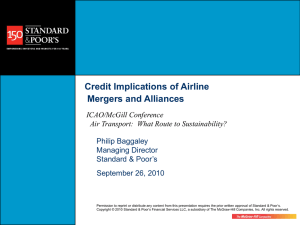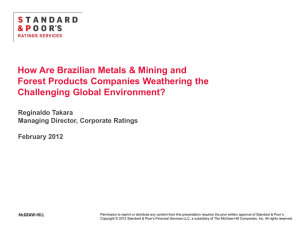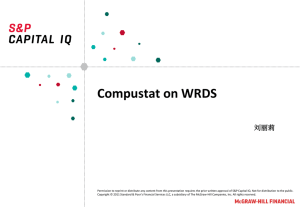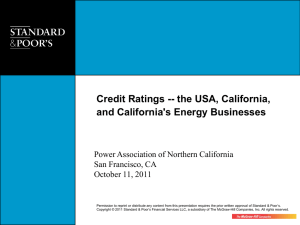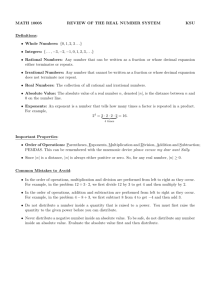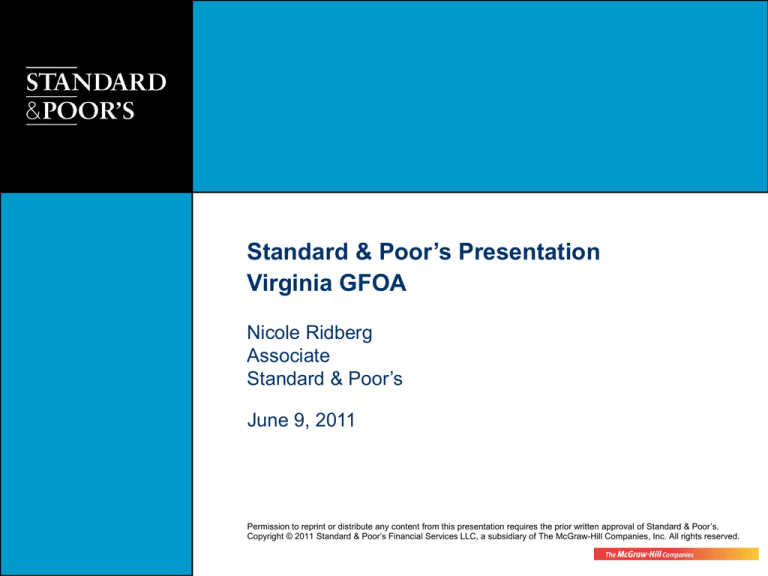
Standard & Poor’s Presentation
Virginia GFOA
Nicole Ridberg
Associate
Standard & Poor’s
June 9, 2011
Permission to reprint or distribute any content from this presentation requires the prior written approval of Standard & Poor’s.
Copyright © 2011 Standard & Poor’s Financial Services LLC, a subsidiary of The McGraw-Hill Companies, Inc. All rights reserved.
S&P’s Overview of U.S. Public Finance
In the aftermath of the recent economic recession, U.S. state and local
governments face budget, policy and in some cases political crises
but we do not believe they face a debt crisis where there will be
widespread defaults.
Recap of Our View of the Current Environment
• Governments have experienced significant fiscal stress since 2008
• Most U.S. state and local governments issue amortizing debt for
capital purposes and not to finance their budget
• Debt obligations are secured either by a specific pledge of the
government’s full taxing authority or dedicated taxes, user revenues
or fees. In some cases, constitutional or statutory provisions may
strengthen bondholders’ claims.
Permission to reprint or distribute any content from this presentation requires the prior written approval of Standard & Poor’s.
2.
Virginia Credits in General
Permission to reprint or distribute any content from this presentation requires the prior written approval of Standard & Poor’s.
3.
Virginia in General
• In our opinion, localities in Virginia have managed well
throughout the recession
• We believe that Virginia credits generally maintain strong credit
characteristics including:
– Diverse local economies that have performed well throughout the
recession
– Conservative budgeting practices that have resulted in solid financial
positions
– Strong management teams that have adopted comprehensive financial
policies and procedures
Permission to reprint or distribute any content from this presentation requires the prior written approval of Standard & Poor’s.
4.
Approximately 75% of Standard & Poor’s public GO ratings on Virginia
localities are considered high investment grade:
A
8%
AAA
20%
A+
17%
AA+
14%
AA19%
AA
22%
Permission to reprint or distribute any content from this presentation requires the prior written approval of Standard & Poor’s.
5.
Virginia’s Economy
In our view, Virginia’s economy has several fundamental
economic strengths, including:
– A sizable and stable federal and military employment base, which has
kept unemployment well below national levels throughout the recession;
– Favorable business climate, including low costs, right-to-work laws and
an extensive transportation network;
– Highly educated workforce and extensive higher education system;
– Growing population and above average income levels;
Permission to reprint or distribute any content from this presentation requires the prior written approval of Standard & Poor’s.
6.
Pensions
Permission to reprint or distribute any content from this presentation requires the prior written approval of Standard & Poor’s.
7.
Pensions: Overview
• In our view, pensions are not presently jeopardizing issuers’ capacity
to meet their debt service obligations;
• Upward pressure on recommended contributions persists;
• Lower discount rates would increase recommended contributions
further;
• Pension reforms efforts are underway in numerous states. Fiscal
relief from these reforms remains to be seen;
• Deteriorating funded ratios and a lack of full actuarial contributions
introduce potential for negative pressure on credit.
Permission to reprint or distribute any content from this presentation requires the prior written approval of Standard & Poor’s.
8.
Virginia’s Pension Systems
• Commonwealth operates 4 defined benefit pension funds:
– Virginia Retirement System (VRS)
– State Retirement System (SPORS)
– Virginia Law Officer’s Retirement System (VaLORS)
– Judicial Retirement System (JRS)
• Membership is determined by age and years of service
• Each localities’ contribution is determined by the
commonwealth per an actuarial study performed every two
years by the systems’ board of trustees
• VRS is the largest fund, with approximately 331,000 active
participants
Permission to reprint or distribute any content from this presentation requires the prior written approval of Standard & Poor’s.
9.
Virginia’s Pension Systems
• The most recent actuarial study was performed for June 30,
2009
• Funding levels dropped for all 4 funds compared to 2008;
however, they remain below-average to average:
– VRS: 80.2% funded
– SPORS: 73.6% funded
– VaLORS: 64.7% funded
– JRS: 72.5% funded
Permission to reprint or distribute any content from this presentation requires the prior written approval of Standard & Poor’s.
10.
Current Credit Implications Of Pension Funding
• Long-term liability that would likely improve if it were managed
now;
• Governments that are not addressing their liabilities now could
face credit pressure;
• Instances of negative rating movement and rating outlook
actions linked to management of pension liabilities exist;
– Rating action linked to pension pressures to date is gradual in nature
reflecting what we view as an erosion of credit quality due to poorly
managed pension liabilities
Permission to reprint or distribute any content from this presentation requires the prior written approval of Standard & Poor’s.
11.
GASB 54
Permission to reprint or distribute any content from this presentation requires the prior written approval of Standard & Poor’s.
12.
GASB 54
• New classifications intended to make fund accounting in
general, and fund balance reporting in specific, more consistent
and transparent
• New classifications:
– Non-spendable--balances that cannot be spent because they are either
illiquid or legally or contractually required to be maintained intact;
– Restricted--constraints placed on these resources that were either
externally imposed or mandated by law;
– Committed--funds that can only be used for certain purposes as per a
formal action by that government's highest level of decision-making
authority;
– Assigned--funds that are constrained by the government's intent of use
for a certain purpose, but are neither restricted nor committed; and
– Unassigned--the residual classification for the general fund.
Permission to reprint or distribute any content from this presentation requires the prior written approval of Standard & Poor’s.
13.
GASB 54
• How will this new rule affect Standard & Poor’s view of the
creditworthiness of U.S. Public Finance issuers?
– We expect to soon be updating the language in our credit analyses, and
our opinion of the relative strengths of the respective issuer's reserve
levels, to incorporate these new classifications.
– Over time, we expect to have sufficient data to also update various
statistical summary credit comments to include GASB 54. However, at
this time, we do not believe the recharacterization of fund balance labels
will, by themselves, materially affect credit.
– For more information, please see our Credit FAQ published on February
24, 2011.
Permission to reprint or distribute any content from this presentation requires the prior written approval of Standard & Poor’s.
14.
Questions?
Nicole Ridberg, Associate
Phone: 212-438-4701
Email: nicole_ridberg@SandP.com
Timothy Barrett, Associate
Phone: 212-438-6327
Email: timothy_barrett@SandP.com
Permission to reprint or distribute any content from this presentation requires the prior written approval of Standard & Poor’s.
15.
www.standardandpoors.com
Copyright © 2011 by Standard & Poor’s Financial Services LLC (S&P), a subsidiary of The McGraw-Hill Companies, Inc. All rights reserved. No content (including ratings, credit-related analyses and data,
model, software or other application or output therefrom) or any part thereof (Content) may be modified, reverse engineered, reproduced or distributed in any form by any means, or stored in a database or
retrieval system, without the prior written permission of S&P. The Content shall not be used for any unlawful or unauthorized purposes. S&P, its affiliates, and any third-party providers, as well as their
directors, officers, shareholders, employees or agents (collectively S&P Parties) do not guarantee the accuracy, completeness, timeliness or availability of the Content. S&P Parties are not responsible for any
errors or omissions, regardless of the cause, for the results obtained from the use of the Content, or for the security or maintenance of any data input by the user. The Content is provided on an “as is” basis.
S&P PARTIES DISCLAIM ANY AND ALL EXPRESS OR IMPLIED WARRANTIES, INCLUDING, BUT NOT LIMITED TO, ANY WARRANTIES OF MERCHANTABILITY OR FITNESS FOR A PARTICULAR
PURPOSE OR USE, FREEDOM FROM BUGS, SOFTWARE ERRORS OR DEFECTS, THAT THE CONTENT’S FUNCTIONING WILL BE UNINTERRUPTED OR THAT THE CONTENT WILL OPERATE
WITH ANY SOFTWARE OR HARDWARE CONFIGURATION. In no event shall S&P Parties be liable to any party for any direct, indirect, incidental, exemplary, compensatory, punitive, special or
consequential damages, costs, expenses, legal fees, or losses (including, without limitation, lost income or lost profits and opportunity costs) in connection with any use of the Content even if advised of the
possibility of such damages.
Credit-related analyses, including ratings, and statements in the Content are statements of opinion as of the date they are expressed and not statements of fact or recommendations to purchase, hold, or sell
any securities or to make any investment decisions. S&P assumes no obligation to update the Content following publication in any form or format. The Content should not be relied on and is not a substitute for
the skill, judgment and experience of the user, its management, employees, advisors and/or clients when making investment and other business decisions. S&P’s opinions and analyses do not address the
suitability of any security. S&P does not act as a fiduciary or an investment advisor. While S&P has obtained information from sources it believes to be reliable, S&P does not perform an audit and undertakes
no duty of due diligence or independent verification of any information it receives.
S&P keeps certain activities of its business units separate from each other in order to preserve the independence and objectivity of their respective activities. As a result, certain business units of S&P may
have information that is not available to other S&P business units. S&P has established policies and procedures to maintain the confidentiality of certain non–public information received in connection with
each analytical process.
S&P may receive compensation for its ratings and certain credit-related analyses, normally from issuers or underwriters of securities or from obligors. S&P reserves the right to disseminate its opinions and
analyses. S&P's public ratings and analyses are made available on its Web sites, www.standardandpoors.com (free of charge), and www.ratingsdirect.com and www.globalcreditportal.com (subscription), and
may be distributed through other means, including via S&P publications and third-party redistributors. Additional information about our ratings fees is available at www.standardandpoors.com/usratingsfees.
Permission to reprint or distribute any content from this presentation requires the prior written approval of Standard & Poor’s.
16.
STANDARD & POOR’S, S&P, GLOBAL CREDIT PORTAL and RATINGSDIRECT are registered trademarks of Standard & Poor’s Financial Services LLC.

